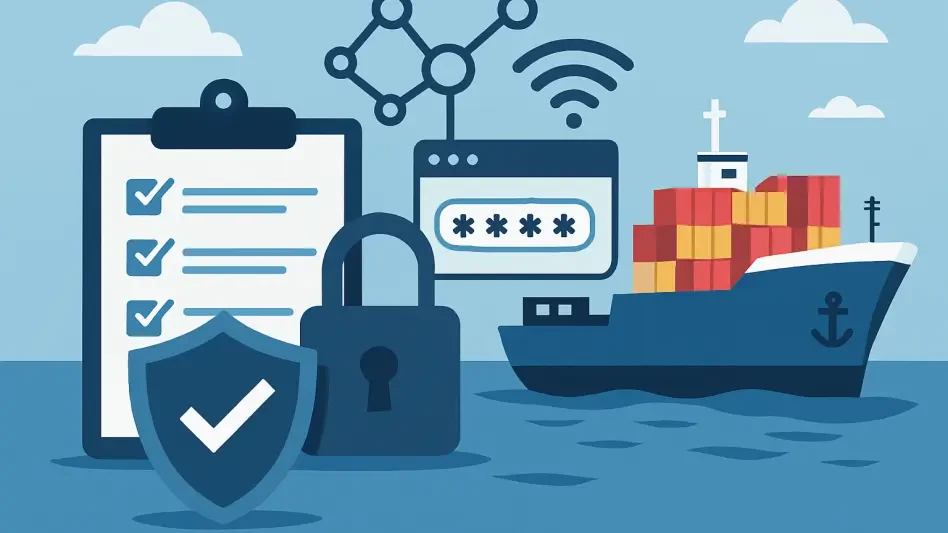The maritime industry stands as a vital pillar of U.S. national infrastructure, facilitating the transport of goods and people while supporting economic stability. However, this critical sector faces an alarming rise in cyber threats that could disrupt operations, endanger lives, and compromise safety on a massive scale. High-profile incidents, such as the ransomware attack on a major U.S. pipeline in 2021, exposed the devastating potential of digital breaches, with ripple effects like fuel shortages and supply chain breakdowns. In response, the U.S. Coast Guard has introduced sweeping cybersecurity regulations, effective from July 2025, aimed at fortifying vessels and facilities against these invisible yet potent dangers. The question looms large: how will these new rules reshape maritime safety? This article delves into the motivations behind the regulations, their key components, the entities they affect, the timeline for compliance, and both the immediate challenges and long-term benefits for the industry.
Addressing a Growing Digital Threat to Maritime Operations
The driving force behind the Coast Guard’s new cybersecurity regulations is the escalating sophistication and frequency of cyberattacks targeting critical infrastructure. The 2021 pipeline incident, which triggered widespread fuel shortages and disrupted supply chains, underscored the vulnerability of interconnected systems. In the maritime sector, a single breach could paralyze navigation systems, halt port operations, or even cause catastrophic spills of hazardous cargo, posing direct threats to human life and environmental safety. Foreign adversaries and criminal organizations increasingly exploit these weaknesses, making proactive defense not just necessary but urgent. The regulations aim to bridge this gap by mandating robust digital safeguards, ensuring that the maritime industry isn’t a weak link in national security. By prioritizing cybersecurity, the Coast Guard seeks to prevent digital disruptions from translating into tangible, on-the-water disasters that could have far-reaching consequences.
Beyond the immediate need to counter specific threats, these regulations reflect a broader recognition of the maritime sector’s role in global trade and safety. A cyberattack on a major port or vessel could delay shipments, strand crews, or compromise emergency response capabilities, amplifying risks across multiple domains. The Coast Guard’s approach is rooted in the understanding that digital and physical safety are intertwined—protecting one requires securing the other. This initiative aligns with national efforts to harden infrastructure against evolving threats, acknowledging that inaction could invite more frequent and severe incidents. While the focus is on prevention, the rules also prepare operators to respond effectively if an attack occurs, minimizing damage and ensuring continuity of operations. This dual emphasis on defense and resilience marks a significant shift in how maritime safety is conceptualized in an increasingly connected world.
Core Elements of the Cybersecurity Framework
Central to the new regulations is the requirement for maritime operators to develop and maintain Coast Guard-approved cybersecurity plans tailored to their specific vessels and facilities. These plans must outline strategies for preventing, detecting, and responding to cyber incidents, ensuring a comprehensive approach to digital safety. A key mandate is the appointment of a Cybersecurity Officer, who serves as the primary point of contact for the Coast Guard and oversees compliance on a 24/7 basis. Technical safeguards, such as multifactor authentication, data encryption, and automatic account lockouts, are also required to secure critical systems against unauthorized access. These measures aim to eliminate basic vulnerabilities, strengthening the industry’s defenses against attacks that could disrupt safe navigation or cargo handling. By embedding cybersecurity into operational frameworks, the rules strive to protect both human lives and the environment from digital threats.
In addition to technical requirements, the regulations emphasize the importance of personnel readiness through structured training and regular exercises. All staff with access to computer systems must complete cybersecurity training to identify potential threats, detect breaches, and report them promptly to the designated officer. Furthermore, operators are required to conduct cybersecurity drills twice a year and full-scale exercises at least once every 18 months to test their response capabilities under simulated attack scenarios. These activities focus on honing skills in detection, mitigation, and recovery, ensuring that theoretical knowledge translates into practical action. Such preparedness is critical in a sector where a delayed response to a cyber incident could escalate into a safety crisis, such as a vessel collision or a hazardous material leak. This holistic approach underscores the Coast Guard’s commitment to building a culture of vigilance across the maritime industry.
Defining the Scope of Affected Entities
The scope of the new cybersecurity regulations is deliberately targeted to focus on high-risk segments of the maritime industry, where the consequences of a cyberattack could be most severe for safety. U.S.-flagged vessels, including oceangoing cargo ships, tankers, offshore supply vessels, and passenger vessels carrying over 150 passengers, fall under these rules. Additionally, towing vessels longer than eight meters handling tank barges and certain passenger vessels on international voyages are included, capturing even smaller operations with significant risk profiles. Shoreside, the regulations apply to major facilities such as container terminals, petroleum transfer sites, cruise ship terminals, and barge fleeting areas dealing with hazardous materials in bulk. This targeted approach ensures that resources and efforts are directed toward protecting critical points of vulnerability, where a breach could directly threaten crew safety, public health, or environmental integrity.
Exemptions are provided for smaller or less critical operations to avoid overburdening entities with minimal risk exposure. Inland vessels like harbor tugs, crane barges, and local workboats generally fall outside the regulations unless they are linked to regulated cargo or passenger thresholds. Similarly, small marinas, yacht clubs, and local boatyards are typically not covered unless they serve vessels under the regulatory umbrella. This delineation reflects a balanced strategy, concentrating on areas where cyber incidents could lead to catastrophic outcomes, such as disrupting navigation systems on a tanker or causing operational failures at a busy port. By focusing on high-stakes environments, the Coast Guard aims to maximize the impact on maritime safety without imposing unnecessary compliance burdens on smaller players, ensuring that safety enhancements are both effective and feasible for the industry as a whole.
Phased Compliance Timeline for Implementation
To facilitate a smooth transition, the Coast Guard has established a phased timeline for compliance with the cybersecurity regulations, balancing urgency with practicality. Starting July 16, 2025, all covered entities must report any cyber incidents to the National Response Center immediately, ensuring rapid awareness and response to threats that could affect safety. By January 12, 2026, personnel training programs must be fully implemented, with annual refreshers to maintain a high level of readiness among crews and staff. This early focus on reporting and training aims to address immediate vulnerabilities, such as delayed detection of breaches, which could compromise vessel or facility safety. The timeline provides a structured path for operators to build their cybersecurity capacity without overwhelming existing safety protocols, recognizing the complexity of integrating digital defenses into maritime operations.
Further milestones extend the compliance framework over the next few years to ensure comprehensive adoption. By July 16, 2027, operators must submit their cybersecurity plans or amendments to existing security plans for Coast Guard approval, alongside completing their first annual cybersecurity assessment. Penetration testing, simulating real-world attacks to identify weaknesses, is required every five years during plan renewal. This gradual rollout allows time to hire and train Cybersecurity Officers, upgrade systems, and conduct necessary drills, minimizing disruptions to day-to-day safety operations. The structured timeline underscores the Coast Guard’s intent to fortify the maritime sector against digital threats while acknowledging the practical challenges of implementation, ensuring that safety remains paramount throughout the transition period and beyond as the industry adapts to a new era of cyber resilience.
Immediate Operational and Safety Challenges
In the short term, the introduction of these cybersecurity regulations is likely to present significant challenges to maritime operations and safety. The financial burden of compliance, including hiring dedicated Cybersecurity Officers, training personnel, and investing in advanced security technologies, could strain budgets, particularly for operators with limited resources. These costs may divert funds from other critical safety measures, such as equipment maintenance or crew training in traditional areas, temporarily heightening operational risks. Moreover, the focus on meeting cyber compliance deadlines might distract from day-to-day safety priorities, potentially creating gaps in preparedness for physical hazards like severe weather or mechanical failures. The Coast Guard’s intent is to enhance overall safety, but the initial adjustment period could inadvertently introduce friction as the industry grapples with balancing multiple safety demands under constrained resources.
Another pressing concern is the potential rise in insurance costs as the maritime sector adjusts to heightened awareness of cyber risks. Insurers may increase premiums to account for the growing likelihood of digital attacks and the associated costs of downtime, data recovery, or liability claims, further pressuring operational budgets. For smaller operators near the regulatory threshold, these financial strains could limit their ability to maintain robust safety programs, indirectly affecting crew welfare and vessel reliability. Additionally, the learning curve associated with new cybersecurity protocols may lead to implementation errors or oversights, temporarily increasing vulnerability to attacks that could disrupt safe navigation or cargo handling. While these challenges are not insurmountable, they highlight the complex interplay between digital and physical safety during the early stages of regulatory adoption, necessitating careful management to minimize unintended consequences.
Future Prospects for Enhanced Safety and Stability
Looking ahead, the long-term impact of the Coast Guard’s cybersecurity regulations holds considerable promise for enhancing maritime safety and operational stability. By mandating robust digital defenses, these rules are poised to reduce the frequency and severity of cyberattacks that could jeopardize vessels, crews, and cargo. A successful breach prevention strategy could avert scenarios like navigation system failures or port shutdowns, directly safeguarding lives and the environment from harm. As operators integrate cybersecurity into their safety frameworks, the industry is likely to develop greater resilience against evolving threats, ensuring that digital risks do not undermine the ability to navigate safely or handle hazardous materials. This proactive stance could redefine safety standards, positioning the maritime sector as a leader in infrastructure protection amidst a landscape of increasing digital interconnectedness.
Beyond immediate safety gains, the regulations may yield broader benefits over time, particularly in terms of risk predictability and financial stability. With fewer successful cyberattacks, insurers might gain confidence in the industry’s ability to manage digital threats, potentially leading to stabilized or even reduced premiums as loss patterns become more predictable. This could alleviate some of the short-term financial pressures, allowing operators to reinvest in both cyber and physical safety measures. Furthermore, the emphasis on training and regular exercises is expected to foster a culture of preparedness, equipping personnel to handle crises with greater efficiency, whether they stem from digital or traditional sources. As the maritime industry adapts to these regulations, the synergy between cybersecurity and operational safety could create a stronger, more dependable framework, ensuring that the sector remains a secure and vital component of national infrastructure for years to come.








